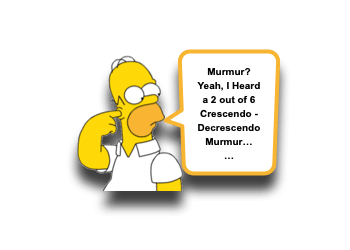Pediatric Murmurs

Ok, so I know that we are in the middle of a Pandemic of COVID-19, but we still need to stay vigilant for all the other treacherous and challenging conditions. With all of the anxiety that is surrounding the pandemic, I won’t be surprised if we start to see some more “syncope” related encounters. (I just had a patient who is a stellar student now being extremely stressed by all of the “virtual” learning she has to figure out in her sophomore year of high school. I completely understand… as I am stressed by all of the virtual meetings I need to go to.) Syncope is a common presentation in the Pediatric ED for certain. Fortunately, while there are concerning causes (ex, Brugada Syndrome, SVT, PE, Prolonged QTc Syndrome, Catecholaminergic Polymorphic VTach, Heart Failure), most are benign (ex, Hair Grooming)… provided your history and examination are not alarming. What if, however, you hear a murmur? Let’s not overreact just yet… let’s take a minute to review something simple that you can do to help alleviate your concern of Pediatric Murmurs:
Pediatric Murmurs: Basics
- Cardiac murmurs are due to turbulent blood flow.
- May be to abnormal cardiac structures (congenital heart disease).
- Can also be due to “vigorous” flow:
- During fevers
- With anemia
- During excitement
- Describing cardiac murmurs:
- Location
- Aortic, Pulmonic, Tricuspid, Mitral, Erb’s point (where S1 and S2 are heard equally)
- Timing
- Systolic, Holosystolic, Diastolic
- Shape
- Crescendo, Decrescendo, Crescendo-Decrescendo
- Radiation
- ex, to back, to axilla
- Pitch
- High vs Low
- Quality
- ex, Harsh, Musical, Blowing, Rumbling
- Intensity
- Often “graded” by the Levine Scale [Silverman, 2008]
- Scale of 1 to 6:
- Grade 1: Faint. Heard only after a few seconds have elapsed (I can’t hear it)
- Grade 2: Faint, but heard immediately (I may agree that you hear it)
- Grade 3: Moderately loud murmur; Prominent (Yes, I can hear this one)
- Grade 4: Loud murmur: Associated with Thrill
- Grade 5: Very loud murmur. Can be heard even if only the edge of the stethoscope is in contact with the skin. + Thrill.
- Grade 6: Loudest possible murmur. The murmur can be heard with the stethoscope not touching the skin. + Palpable Thrill.
- Location
- Cardiac murmurs are commonly heard during routine examination.
- Fortunately, most are benign, but may also be the initial sign of congenital heart disease.
- ~50% of school-aged children will have a non-pathologic murmur noted like:
- Still’s murmur
- Pulmonary flow murmur
- Peripheral pulmonary artery stenosis murmur
- Venous hum
- Supraclavicular arterial bruit murmur
Pediatric Murmurs: Helping Findings
- Since detection of a murmur may lead to some concern (given clinical scenarios), it is important to help avoid over-exuberant testing for “innocent” or non-pathologic murmurs.
- Some characteristics that favor “innocent” murmurs include:
- Systolic ejection timing and Short in duration
- – diastolic or holosystolic are concerning features.
- Musical or Vibratory quality
- – harsh or blowing are concerning.
- No extra heart sounds
- – systolic clicks, rubs, or gallops are concerning.
- Normal S1 and S2
- – abnormal S2 (loud or split) are concerning.
- Grades 1 or 2
- – higher grades do not equate to congenital heart disease, but lower grades are more associated with innocent causes.
- Murmurs that are sometimes not present (variable presentation with fevers, tachycardia, etc)
- – murmurs that are consistently documented may be more related to anatomic abnormality.
- Decrease in Intensity or Disappear with Upright Position [Lefort, 2017]
- – increasing with upright position is more concerning.
- Systolic ejection timing and Short in duration
- Look for other concerning associations:
- Underlying genetic disorder (ex, Down’s Syndrome)
- < 1 year of age
- Family history of sudden death or congenital heart disease
- Abnormal pulses
- Symptoms / Signs of heart disease
- Hepatomegaly
- Abnormal ECG (if obtained)
- Cadiomegaly or pulmonary edema on CXR (if obtained)
Moral of the Morsel
- Murmurs happen. Some may not have been documented before, and that does not necessarily mean that they are more concerning in children… it may just be that current fever and increased cardiac activity has created more turbulence.
- More than Just the Murmur! Consider the entire presentation and include family history… and don’t forget to feel for the liver and all 4 extremity’s pulses!
- Move the Patient! Changing the position of the patient can help improve your diagnostic certainty… murmurs that reduce or go away upon standing up are reassuring!

